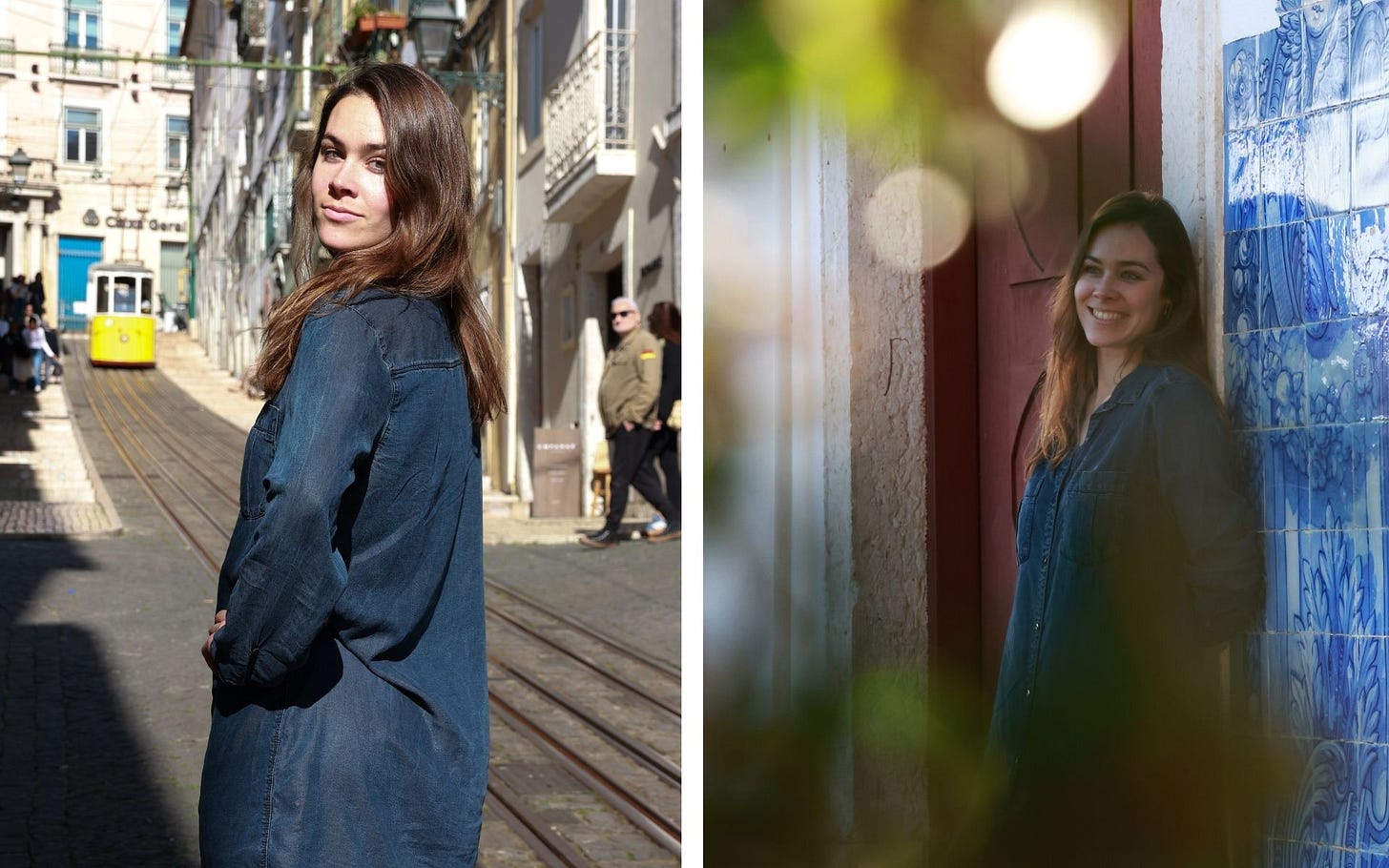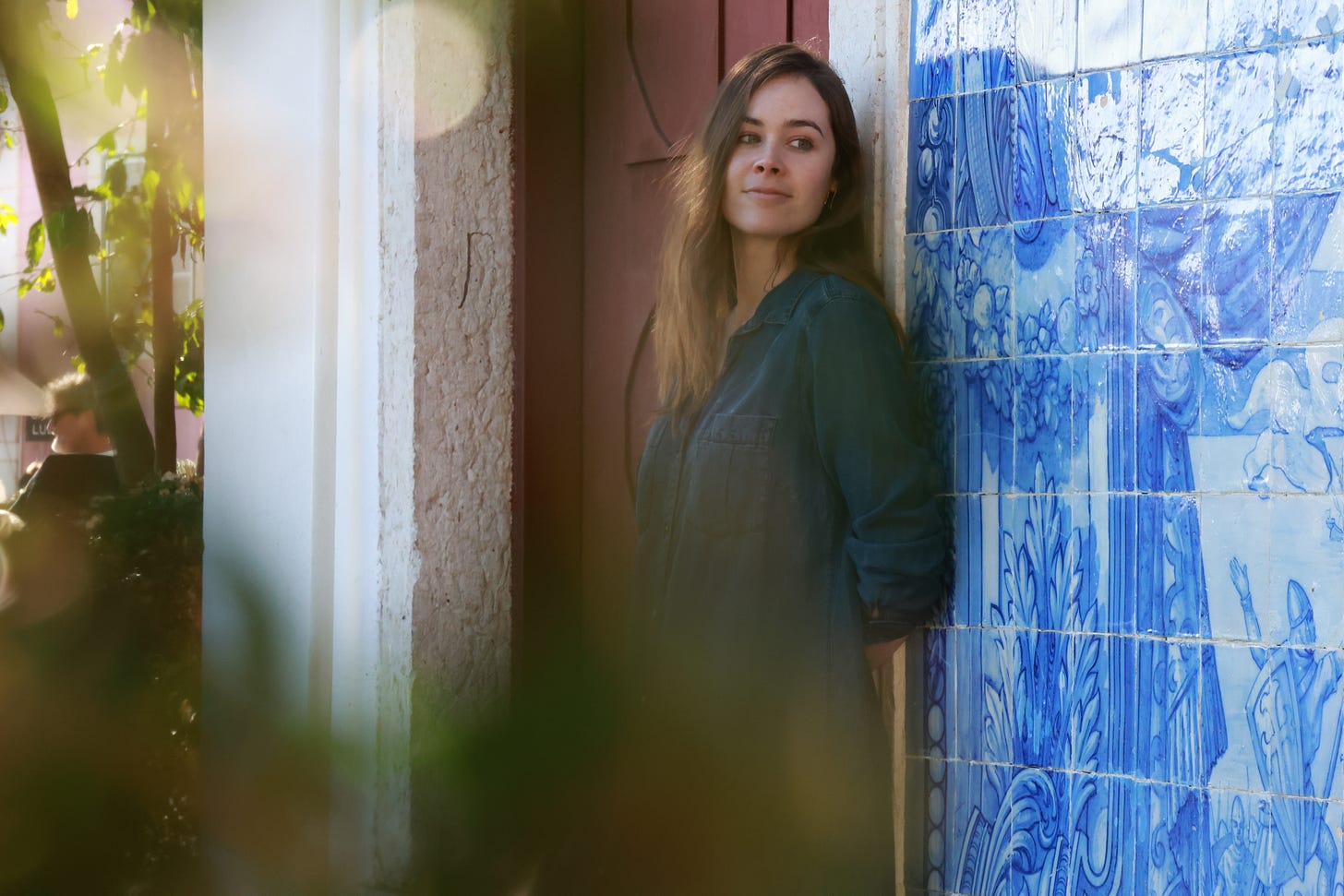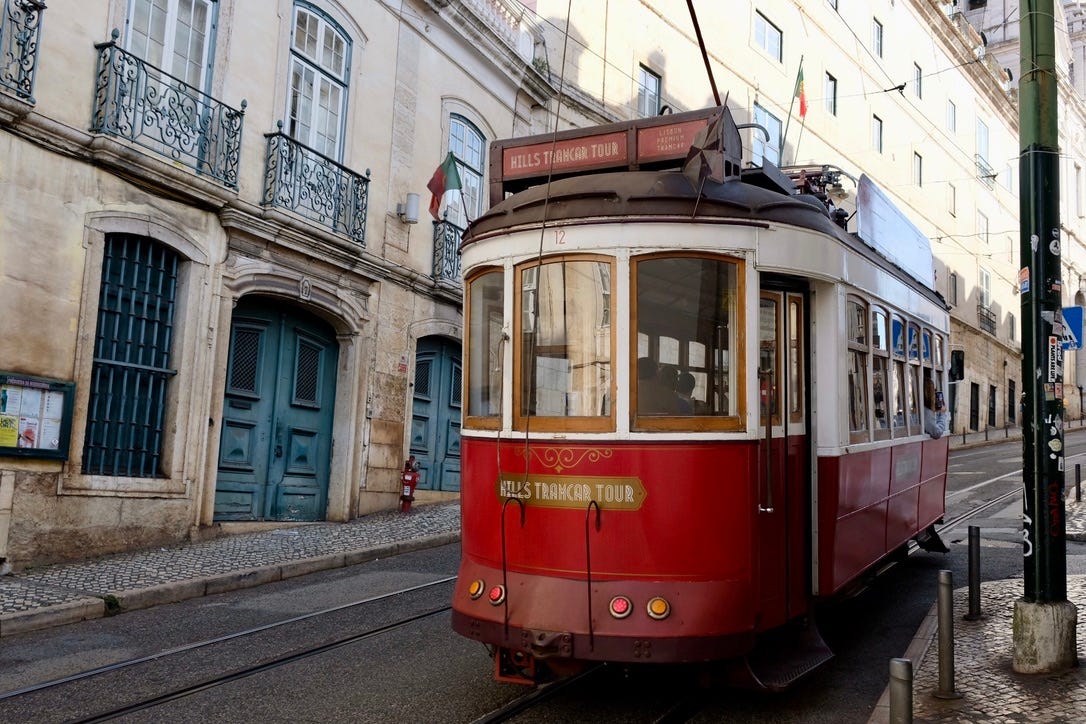A profound experiment in vanity
What a silly photoshoot in Lisbon taught me about self-perception.
On a trip to Lisbon last year with one of my oldest and dearest friends, I embarked upon an exercise in vanity and mortification: A cheap, touristy photoshoot, booked via Airbnb.
We did it because we thought it would be fun, and also because why not. But the shoot itself turned out to be less glamorous than humiliating. Neither of us have been trained to pose nor have we spent sufficient hours perfecting our angles in front-facing cameras. The midday sun was way too bright, so we squinted into the lens. We were those annoying people whose #content photoshoot was very much in the way. When the photographer showed us how “great” we looked in between shots, we looked grossly overexposed—perhaps even more so than we felt, as we were posing in Lisbon’s most touristy quarters. Ugh, I kept thinking. Why do I suck so much at this?
When we got the photos back, we both did that classic thing: “How do you look so good?! I look awful in all of these.”
We struggled to find images we liked of ourselves, even as the other insisted we looked great. It reminded me of the selfie sessions we used to do in high school with the MacBook Photobooth app, posting silly faces by the dozens to MySpace or Facebook. This time, however, our self-criticism came with conviction.
It struck me as odd. We’re both educated, confident women with many professional successes. How could it be that we genuinely believed there were objectively great pictures of each other, yet could not trust assertions that there were objectively great pictures of ourselves? Either we were both wrong, or we were both lying.

We wanted to know if we could trust our own perceptions of where we look “good,” so we decided to run an experiment. I created four Google Drive folders, and we separately filled them with our favorite images: Karri’s favorites of herself and of me, and my favorites of myself and of her. Only after we both went through all of them did we compare.
The result was astonishing: Out of six hundred raw images, there were four we agreed upon.
Karri was more selective in her picks, choosing just her fifteen favorites in total. I found more than sixty where I thought she looked great, and about thirty of myself that I didn’t love but thought could be passable if they were edited properly or cropped in a more flattering way. Even still, there was almost no overlap.
I had assumed our picks would be different, but I didn’t think the difference would be this dramatic. When I looked through the images Karri chose of me and compared them to the ones I selected, I felt like I was looking at a version of myself I didn’t recognize. She chose photos that made me cringe when I first saw them, and she chose almost zero of the images I believed were good.
The photographer sent us his entire camera roll, so there are a lot of frames shot in quick succession that look only very slightly different at a passing glance. I remember looking closely at the angles and expressions to analyze which ones I thought were “best.” Apparently, I chose wrong. In a set of three successive images, Karri chose the ones immediately before and after the one that I chose.

This made me question everything about the way I perceive myself. Have I been wrong this entire time about what looks “good?” What if I’m actually looking like a fool whenever I think I’m having a good hair day?
I don’t have a satisfying answer for why we had such different opinions about each other’s best angles. My best guess is that our perception of ourselves is missing an entire dimension, and friends simply have a lot more information about how we exist in the world. Maybe their definition of a “good” or “flattering” photo is one that seems most accurate to them, one that most closely resembles, in 2D form, the way we exist in their lives.
When I think back on this experiment now, for example, I remember thinking that it was hard to narrow it down. There were six hundred images; of course it was hard to narrow it down. The photos I loved most of her weren’t just photos where she appeared beautiful, but photos that also felt like they conveyed the Karri I know and love—someone who is fun, witty, and brilliant, who makes me feel loved, seen, and at ease.
That’s a dimension we can’t analyze for ourselves. We can only groom and beautify ourselves based on the angles we can see in the mirror, so our perception of our “best” looks is based, perhaps, on how closely we can get those visible angles to resemble something from a magazine without looking unrecognizable.
When we see an image at an unfamiliar angle, it’s uncomfortable. It’s not part of our frame of reference for how we show up to other people. It’s a reminder that only so much of others’ perceptions of us are within our control.
When we first conducted this experiment, I thought of it only as an exercise in understanding our “objective” appearance. Since then, however, I’ve realized this applies to far more than just our physical appearance. If we can’t trust our own opinions of what we look like in photos, how can we give so much credibility to our self-doubt and harsh self-criticism?
Realizing just how little I understand about the way others perceive me has been exhilarating, terrifying, and freeing. No matter how much I try to control how I show up to other people, there will always be something that’s out of my field of view. I can try to control my image or my personality, but I can’t make people feel any certain way about it. It doesn’t matter how “perfectly” I do something or how “nice” I am or how far out of my way I go to make a kind gesture. The only person whose opinion I can ever truly know is my own.
There is a side of this that is disconcerting in a scary way: There are probably hundreds of small ways we’ve all accidentally embarrassed ourselves or hurt someone’s feelings without realizing it. We say offensive things without realizing they’re insensitive, for example, or we don’t show up for a party thinking our absence won’t be noticed when we are, in fact, sorely missed. We don’t get a report card at the end of every day that gives us a score for how we’ve shown up in the world, so we can’t possibly know the true impact of all of our words and actions.
At the same time, there are things our friends love about us that we have no idea are defining elements of how they see us. For every time you’ve disappointed someone, there have probably been a dozen that you’ve showed up in a meaningful way just by being who you are, without even trying to do something good. How many times has someone else—friend, family, or stranger—brightened your mood or changed the course of your day with a well-timed compliment or a small but incredibly helpful favor you didn’t ask for, or by remembering something specific about you that others usually forget? Like, I don’t know, holding a craft night and making sure there’s a pair of left-handed scissors.
Far too often, we focus on our flaws without understanding that there’s an awful lot of good that’s just out of our view. We are more than just the things we do on purpose.
Here’s a small example from my own life: My dad used to travel a lot for work, and there was no FaceTime back then. To feel more connected when he was a thousand miles away, he often reminded us in phone calls or postcards that no matter how far he was, we’d always be looking at the same moon. Even when I visit my family now, I often get texts or phone calls from my parents to “look at the moon!” if they notice it’s looking unusually beautiful after I’ve left the house. I’ve never been annoyed by these messages. It’s such a simple gift, but a meaningful one. It says: we saw this beautiful thing, and, because we love you, we want you to experience it, too. It’s so thoughtful and inclusive, and it’s one of the things that defines my parents to me.
As a result, I’m that weird friend who often texts or calls friends to “go outside” or “look up!!” if I catch a good sunset or giant moon when we’re in the same city. The first time a friend sent one of these texts to me, I felt overcome with joy. It was such a simple thing for her to send, but to me it was a signal that she recognized my very specific love language. It felt like a sign of genuine friendship and connection—a sign that we had both impacted each other in positive ways.
I can’t tell you that this photoshoot experiment has eliminated all of my insecurities forever. I am a person in the world: I have been targeted by beauty marketing, and I have made unforgettable mistakes. Sometimes, that inner voice or those stupid “face yoga” ads on Instagram succeed at making me fear that I’m inadequate in some irreparable way. What I have learned, however, is that I am not a trustworthy self-critic. That’s the freeing part: I might as well waltz through life without worrying what if people don’t like x, y, or z. Even if I do what I think they want from me, or what they think they want from me, I can’t guarantee they’ll like me any better.
When I see pictures of my friends, I view them the way I view good travel photos, or old candid photos from backyard birthday parties and family vacations. It’s not the quality of the frame or the pose that matters, it’s the feeling the image conveys. When I think someone looks great in a photo, it’s not usually because the image looks straight out of a magazine, orchestrated by Annie Leibovitz; it’s because it shows someone I love in context. Because the portrayal of them feels emotionally accurate to me.
I don’t want to see my loved ones all dolled up for society’s definition of beauty. I want to see them just the way I know and love them: unedited.
P.S. Should you find yourself in Lisbon, I invite you to read the top-10 lists and then ignore them completely. I showed up with zero plans and just a few recommendations from a friend who’d been for a weekend, and I was more than suitably entertained. Of all the places I have ever been, I have the fewest specific recommendations for Lisbon and yet it was one of the most delightful places I have ever traveled. Don’t go to Lisbon to “do” Lisbon. Go to Lisbon to live there, albeit temporarily, by doing the same things you’d do at home, but with better views and older stuff. Go for a walk. Enter a cafe. Read a book. Marvel at the sea.
Enjoy it.
About next week
This newsletter has been a sporadic labor of love since I started sending “The Night Note” many years ago, and it’s been such a wonderful place for me to play around with different kinds of storytelling. Thank you for being here!
A handful of you have signed up as paid subscribers, which means so, so much to me. As a special thank you, next week’s essay will be behind the paywall, just for you. It’s a different kind of travel story, one about going back in time through family history. We found some ancient letters and photographs from relatives on my dad’s side of the family, and it’s been a fascinating discovery. I hope it inspires you to ask more questions of loved ones near and far, while you still can. If you’d like to make sure that piece hits your inbox, you can sign up for a paid subscription here.
I won’t share too much else about what I have in store this year, but let me just say I’m really looking forward to having you along for the adventure.
Talk soon!





Loved all of your pictures and I completely understand how we seem to all have the same criticism of ourselves in pictures. To rid yourself of that is inspiring to say the least!! Never lose that, Kassondra!! It is rare and special to have come to that realization at a young age. BTW, both of your are beautiful!!
A lovely piece (as also mentioned in an e-mail I sent separately)! James